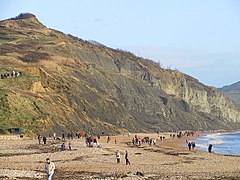| Charmouth Mudstone Formation | |
|---|---|
| Stratigraphic range: Lower Sinemurian– Lower Pliensbachian Semicostatum-lowermost Margaritatus | |
 Cliffs of the Charmouth Mudstone Formation at Charmouth, Dorset | |
| Type | Formation |
| Unit of | Lias Group |
| Sub-units | Shales With Beef Member, Black Ven Marl Member, Belemnite Marl Member, Green Ammonite Member |
| Underlies | Dyrham Formation, Marlstone Rock Formation, unconformity with Gault (Charmouth area) |
| Overlies | Blue Lias Formation, Scunthorpe Mudstone |
| Area | Wessex Basin, Worcester Basin, East Midland Shelf |
| Thickness | ~335 m |
| Lithology | |
| Primary | Shale, mudstone |
| Other | Limestone, sandstone |
| Location | |
| Region | England |
| Country | |
| Type section | |
| Named for | Charmouth |
| Location | Cliff and foreshore exposures between Seven Rock Point and Golden Cap, Dorset |
The Charmouth Mudstone Formation is a geological formation in England, dating to the Early Jurassic (Sinemurian–Pliensbachian).[1] It forms part of the lower Lias Group. It is most prominently exposed at its type locality in cliff section between Lyme Regis and Charmouth (alongside the underlying Blue Lias) but onshore it extends northwards to Market Weighton, Yorkshire, and in the subsurface of the East Midlands Shelf and Wessex Basin. The formation is notable for its fossils, including those of ammonites and marine reptiles and rare dinosaur remains. The formation played a prominent role in the history of early paleontology, with its Lyme Regis-Charmouth exposure being frequented by fossil collectors including Mary Anning.
- ^ British Geological Survey. "Charmouth Mudstone Formation". BGS Lexicon of Named Rock Units. Retrieved 2018-03-08.